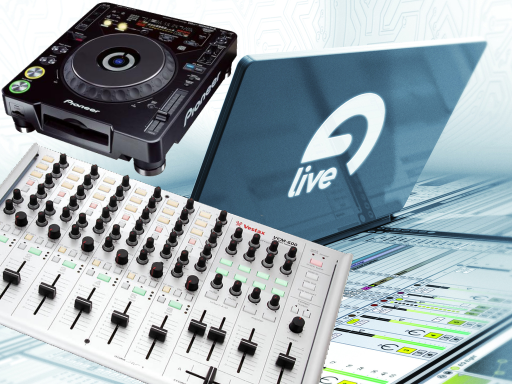
If you’ve jumped on the bandwagon and got yourself a copy of Ableton Live, taught yourself the basics, figured out how to DJ with it and are now ready to perform in public, the only question you might be left asking is:
“How do I beatmatch Live to the DJ before me?”
EDIT: If you prefer to use Traktor Pro to DJ with then check here instead
The same problem surfaces (naturally) when you play back-to-back with someone when one of you want to use CDJ’s (or turntables) and the other on a laptop with Live.
Never fear, Live 7 (&8) are here!
There are two ways you can go about this, one requires no extra hardware, the other requires a midi device with at least one slider available eg. Faderfox LV2, Evolution UC-33 or the Vestax VMC-600.
1) Basic (no controller):
To successfully operate a steady tempo device (Live) in partnership with a variable tempo device (CDJ’s etc) without the use of a a hardware controller you will need to get one thing clear first…
Ableton assumes Master Tempo and all other devices are matched to its tempo.
Once you’ve started the global play on Live you will not need to stop it. From here the CDJ user can will need to beatmatch each new track to Live’s signal. When its time to mix a tune in from Live, you will need to make any tempo adjustments to the CDJ not ableton.
Ways to do this are:
- a) Beatmatch to a guide track from Live (which will be always playing but never heard)
- Create a new audio channel in your Live project
- Route it to a secondary output channel (one not used for your performance)
- Patch that channel into an unused channel on your mixing desk
- Add a standard percussion loop to this channel and have it playing always
- This will be your mixing guide track, make sure it has a clear Kick, Snare and Hats… or whatever you really want to beatmatch to
- Make sure the channels volume is never turned up on the mixing desk
- Now you can monitor/make any tempo adjustments on the CDJ’s even when no track is playing on Live. This will allow you to refer to Live’s tempo at regular itervals to make sure you are not drifitng out of time
- b) Stop/Start Live as close to the beat as you can then have the CDJ’s adjusted (carefully, subtley)
2) Advanced (controller required):
To control Live’s tempo like a CDJ (or turntable) all you need to do is have a midi-assignable slider connected to the laptop and assign it to the global tempo. Then, the trick is to set your Min/Max values to a range of say 5-10bpm MAX…
The smaller the range, the finer the control. So if your set is starting at 127bpm and ending at 130bpm, then make the range like 125-132 to give some room to push pull. Experiment here as you can get away with settings like 127-130 and you’ll get a real fine adjustment curve 

It is also worth assigning the two Nudge buttons (“<<” & “>>”) as these will be handy to give little ‘bumps’ during the mix. I use a combination of both slider & nudge with fairly precise accuracy.
So, to assign your midi slider:
– Turn ON Midi Map mode
- Ctrl-M (PC) / Apple-M (Mac)
– Click on the global bpm (the whole number section not the decimal part)
– Move the slider you want to assign – you will see the assignment appear in the midi list on the right of screen
-> change the min & Max values now to suit. E.g Min = 125; Max = 130
If you wish to assign the Nudge buttons, do so now:
– Click on the Nudge Left button (this will slow down your tempo as long as you hold it)
The arrow at top like this “<<“
– Tap the midi button you wish to assign
– Repeat for Nudge Right (speed up tempo whilst you hold it)
The arrow at top like this “>>“
– Turn Off Midi Map mode
- Ctrl-M again (or Apple-M for Mac)
Note: I often assign nudge to midi & qwerty keyboard buttons for quick access no matter what I’m doing.
To assign to keyboard:
– Turn ON Keyboard Map mode (everything should go orange)
- Ctrl-K (PC) / Apple-K (Mac)
– Click the nudge left
– Tap the key you wish to assign to (I use the square brackets “[” and “]” )
– Repeat for the other nudge button
– Turn OFF Keyboard Map mode
VOILA! You are now ready to boogie 


Pingback: How to mix between Traktor and a CDJ or Turntable | OK KANA()